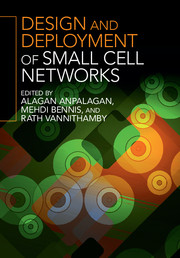Book contents
- Frontmatter
- Contents
- List of contributors
- Preface
- 1 Mobility performance optimization for 3GPP LTE HetNets
- 2 Design and performance analysis of multi-radio small cell networks
- 3 Dynamic TDD small cell management
- 4 3GPP RAN standards for small cells
- 5 Dense networks of small cells
- 6 Traffic offloading scenarios for heterogeneous networks
- 7 Required number of small cell access points in heterogeneous wireless networks
- 8 Small cell deployments: system scenarios, performance, and analysis
- 9 Temporary cognitive small cell networks for rapid and emergency deployments
- 10 Long-term evolution (LTE) and LTE-Advanced activities in small cell networks
- 11 Game theory and learning techniques for self-organization in small cell networks
- 12 Energy efficient strategies with BS sleep mode in green small cell networks
- 13 Mobility management in small cell heterogeneous networks
- 14 The art of deploying small cells: field trial experiments, system design, performance prediction, and deployment feasibility
- 15 Centralized self-optimization of interference management in LTE-A HetNets
- 16 Self-organized ICIC for SCN
- 17 Large-scale deployment and scalability
- 18 Energy efficient heterogeneous networks
- 19 Time- and frequency-domain e-ICIC with single- and multi-flow carrier aggregation in HetNets
- Index
- References
5 - Dense networks of small cells
Published online by Cambridge University Press: 05 December 2015
- Frontmatter
- Contents
- List of contributors
- Preface
- 1 Mobility performance optimization for 3GPP LTE HetNets
- 2 Design and performance analysis of multi-radio small cell networks
- 3 Dynamic TDD small cell management
- 4 3GPP RAN standards for small cells
- 5 Dense networks of small cells
- 6 Traffic offloading scenarios for heterogeneous networks
- 7 Required number of small cell access points in heterogeneous wireless networks
- 8 Small cell deployments: system scenarios, performance, and analysis
- 9 Temporary cognitive small cell networks for rapid and emergency deployments
- 10 Long-term evolution (LTE) and LTE-Advanced activities in small cell networks
- 11 Game theory and learning techniques for self-organization in small cell networks
- 12 Energy efficient strategies with BS sleep mode in green small cell networks
- 13 Mobility management in small cell heterogeneous networks
- 14 The art of deploying small cells: field trial experiments, system design, performance prediction, and deployment feasibility
- 15 Centralized self-optimization of interference management in LTE-A HetNets
- 16 Self-organized ICIC for SCN
- 17 Large-scale deployment and scalability
- 18 Energy efficient heterogeneous networks
- 19 Time- and frequency-domain e-ICIC with single- and multi-flow carrier aggregation in HetNets
- Index
- References
Summary
Introduction
During the last few years, wireless data traffic has skyrocketed, driven mainly by a large penetration of smart phones and devices. In 2013, an exabyte of data traveled across the global mobile network monthly [1]. By 2020, data traffic served by such networks is expected to increase by up to a factor of 100, including traffic generated by the widespread adoption of device–device (D2D) and the Internet of Things (IoT) connected via machine–machine (M2M) communications. It is widely recognized that this general trend toward more explosive growth may accelerate even further in future, and how to meet such a demand has been one of the most active and rapidly growing areas in the wireless communication community in the past decade in terms of both academic and industrial research and development [2].
Facing the unprecedented challenge, the wireless communication community has considered many candidate solutions. A significant portion of these are focused on increasing the communication resources, e.g., deploying more network nodes, which leads to densification of existing networks, utilizing wider bandwidth, increasing antenna numbers, and employing additional resources to offload. Among them, the dense network approach stands out for its high scalability of providing magnitudes of capacity increase. Extensive research has been devoted to dense networks (see e.g., [3–8] and references therein).
Indeed, commercial wireless networks are already becoming denser and dense-network deployment will be a critical factor (together with other solutions) to meet the ever-increasing traffic demand. The trends for traffic and network-density growth over a 20-year span are illustrated in Figure 5.1.
In Figure 5.1, the network densities for the years 2000 to 2015 were estimated from 3GPP publications (e.g., [3, 9], etc.), whereas the network density for year 2020 is a projection based on historic data and recent trends. In more detail, around year 2000, sparse 3G network deployments of macro base stations covered wide areas with typical cell radii of several kilometers. Starting from around 2005, the network density increased to about 10 to 20 nodes/km2 and cell radii shrunk to between one kilometer and several hundreds of meters, according to the study in 3GPP LTE Rel-8/9; however, macro eNBs (evolved NodeB, also known as base stations, BS, BTS, etc.) were still the main focus.
Information
- Type
- Chapter
- Information
- Design and Deployment of Small Cell Networks , pp. 96 - 121Publisher: Cambridge University PressPrint publication year: 2015
References
Accessibility standard: Unknown
Why this information is here
This section outlines the accessibility features of this content - including support for screen readers, full keyboard navigation and high-contrast display options. This may not be relevant for you.Accessibility Information
- 16
- Cited by
